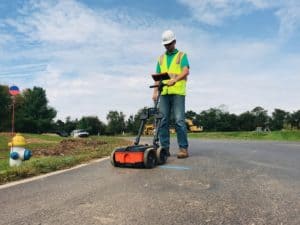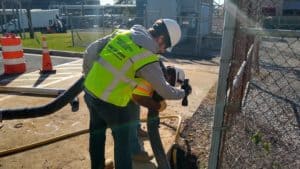What types of utilities are unlocatable?
Ideally, we could answer this question with a black and white answer. Like most topics in the utility locating industry however, surface geophysical equipment, soil conditions, utility compositions, and other factors can really muddy the waters. There is no clear cut answer to define what utilities are unlocatable, because there are too many factors that can affect a technician’s ability to detect the location of an underground utility or structure.
The most common underground utilities that are not locatable on the surface with standard locating equipment can vary depending on the detection equipment that is being used.
Electromagnetic Utility Locating
 In terms of electromagnetic equipment, the types of underground utilities that are unlocatable tend to be pressurized non-metallic pipes or occupied conduits that contain a non-metallic or ungrounded cable. For electromagnetic geophysical equipment to work as designed, an electromagnetic frequency must be applied to a conductor. If there is no conductor, the signal cannot travel through the utility, and thus it cannot be detected. This is why the installation of tracer wire along side the non-conductive utility is so critical, even on water and forced / pressurized sewer pipes.
In terms of electromagnetic equipment, the types of underground utilities that are unlocatable tend to be pressurized non-metallic pipes or occupied conduits that contain a non-metallic or ungrounded cable. For electromagnetic geophysical equipment to work as designed, an electromagnetic frequency must be applied to a conductor. If there is no conductor, the signal cannot travel through the utility, and thus it cannot be detected. This is why the installation of tracer wire along side the non-conductive utility is so critical, even on water and forced / pressurized sewer pipes.
Just because a utility is not locatable with electromagnetic geophysical equipment does not mean that it is unlocatable entirely, there is alternative equipment that may detect it’s location from the surface.
Ground Penetrating Radar
 Ground penetrating radar works by sending pulses of radio frequency into the ground. When those waves are reflected off of objects in the ground, including the ground itself, the waves will travel back to the GPR unit at different velocities. Objects that are conductive will reflect at higher velocities, while objects that are not conductive will reflect at lower velocities. In most cases, the data is displayed and analysed in real time by the GPR survey technician.
Ground penetrating radar works by sending pulses of radio frequency into the ground. When those waves are reflected off of objects in the ground, including the ground itself, the waves will travel back to the GPR unit at different velocities. Objects that are conductive will reflect at higher velocities, while objects that are not conductive will reflect at lower velocities. In most cases, the data is displayed and analysed in real time by the GPR survey technician.
The most common types of utilities that are unlocatable using Ground Penetrating Radar tend to be utilities whose depth exceeds the penetration limit of the transmitted radio waves, and utilities whose material composition has the same conductive properties as the surrounding earth material. When a utility has the same conductive properties as the soil, the utility will not reflect the GPR waves at a different velocity, and will essentially be invisible to the GPR technician. This happens a lot for example when attempting to find terracotta pipes in dense, moist, or clay earth materials.
Vacuum Excavation
 Earlier we talked about our definition of unlocatable utilities. If any evidence exists to suggest the presence of an underground utility, we do not believe we can classify it as unlocatable without first attempting to safely excavate to find the location of the utility or structure. This of course can be a budget buster for most projects. You’ll have to weigh the risks to determine if the investment in exploratory excavating is really worth it.
Earlier we talked about our definition of unlocatable utilities. If any evidence exists to suggest the presence of an underground utility, we do not believe we can classify it as unlocatable without first attempting to safely excavate to find the location of the utility or structure. This of course can be a budget buster for most projects. You’ll have to weigh the risks to determine if the investment in exploratory excavating is really worth it.
If the utility or structure cannot be found using a reasonable amount of exploratory excavation, we can then classify the utility as unlocatable.





One Comment